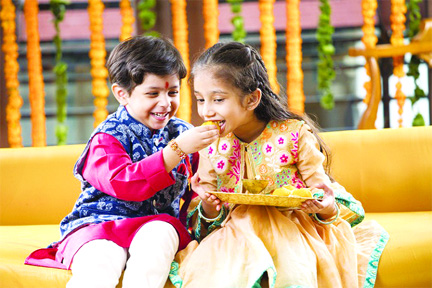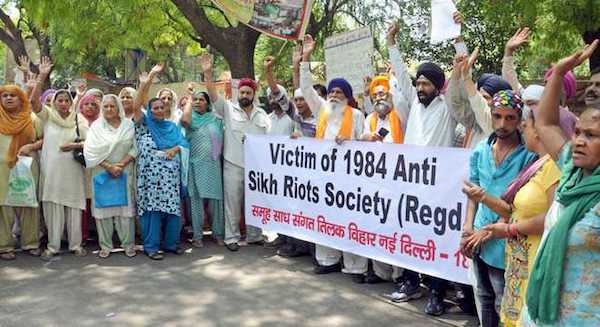
Raksha bandhan is the main festival of Hindus which is celebrated on the full moon day of Shravan and every year the festival comes in August. This festival is celebrated throughout India and Nepal. Raksha bandhan means ‘bondage of security’ and ‘Raksha Bandhan’ in Sanskrit literally means “the knot of security”. Rakhi can be made from cotton such as kalva, silk thread, and gold or silver item. The festival of Raksha Bandhan is the festival of brother and sister. This festival symbolizes the love of brother and sister. On the Raksha bandan, sister prays for her brother’s long life with her prosperity and happiness and binds Rakhi on her brother’s wrist. The brother gives the gift to his sister and promises to protect his sister and take care of him in all circumstances. This festival is celebrated by the Hindu communities including Jain and Sikh religion and other parts of the world. Raksha bandhan has also been an important tradition in the history of Sikhism, which is sometimes called Rakhdi or Rakhri.
Legends and tales of Raksha Bandhan
Draupadi tied Rakhi on Lord Krishna’s wrist
According to ancient scriptures, Lord Krishna was once fighting with the evil King Shishupal, to protect the people. The Lord bore an injury and was left with a bleeding finger. Draupadi tore her saree and tied a piece of cloth around Krishna’s wrist. He was very impressed by her gesture and promised to protect her if ever she needed help. When the Kauravas tried to strip her robes, Krishna appeared and saved her from honour.
The legend of Yama and Yamuna
It is believed that Yama, the deity of death, gained immortality when his sister, Yamuna tied rakhi on his wrist. Yama also affirmed that anyone, who stood by his promise to protect his sister, after the sister ties rakhi on his wrist, would be blessed with a healthy and everlasting life.
Goddess Lakshmi and King Bali
The Hindu mythology believes that King Mahabali was a devout worshiper of Lord Vishnu. The Lord, impressed by his deep devotion, took to caring for his kingdom. To look after his kingdom, Lord Vishnu had to leave his abode in Vaikuntam, leaving Goddess Lakshmi, behind. The Goddess was distraught by Lord’s Vishnu’s decision and she knew that she could not talk him out of his commitment. So, she decided to visit the kingdom, on Shravan Purnima, by concealing her identity. After tying rakhi on Mahabali’s wrist, she revealed her identity and shared her reservation with the king. The king was touched by her plea and in return, begged Lord Vishnu to go back to Vaikuntam. Raksha Bandhan is also referred to as the Baleva festival in some cultures.
Mughal Emperor Humayun and Rani Karnavati
Once when Mewar was attacked by the king of Gujarat, Bahadur Shah, Rani Karnavati, a widow herself, was very concerned about the honour of thousands of her women subjects. She sent a bejeweled Rakhi to Mughal emperor Humayun, who had already captured Delhi Throne, by then, seeking his assistance. Humayun felt honoured and obliged with her request, and moved his forces towards Chittorgarh. However, by the time the forces reached the fort, the womenfolk along with the queen, committed jauhar (self immolation) and chose death over dishonour.
King Porus and Alexander’s wife
Alexander the Great, invaded the Indian sub-continent by 300 B.C. Although he was never defeated in his conquests, this time he faced a formidable opponent, King Porus. Alexander’s wife, Roxana feared for his defeat and death. She came to know about the Raksha Bandhan festival of the region from her close aides. She sent a Rakhi to Porus, and asked him to ‘pull punches’ on Alexander and not to kill him, if they came face-to-face in the war. According to various folklores, this is one of the reasons Porus lost the war, as he was bound by the promise he made in return of the Rakhi.
The legend in the Bhavishya Puran
The legend refers to a war between the Gods and the Demons. The demon King Brutra was advancing and the Gods lead by lord Indra, were on verge of defeat. The king of Gods, Indra approached Guru Brihaspati to find a solution to the situation. Brihaspati asked Indra to tie a sacred thread on his wrist, powered by the sacred mantras on the Shravan Purnima. Lord Indra’s Queen Sachi also called Indrani, empowered the thread and tied it on to his hand on the decided day. The power of the sacred thread called Raksha helped the Gods to victory. The tradition of thread tying still continues. It is a gesture of goodwill.
The legend of King Bali and Goddess Laxmi According to another legend Demon King Bali was a great devotee of Lord Vishnu. Lord Vishnu had taken up the task to guard his kingdom leaving his own abode in Vaikunth. Goddess Laxmi wished to be with her lord back in her abode. She went to Bali disguised as a Brahmin woman to seek refuge till her husband came back. During the Shravan Purnima celebrations, Laxmiji tied the sacred thread to the King. Upon being asked she revealed who she was and why she was there. The king was touched by her goodwill for his family and her purpose and requested the Lord to accompany her. He sacrificed all he had for the Lord and his devoted wife.
Thus the festival is also called Baleva that is Bali Raja’s devotion to the Lord.It is said that since then it has been a tradition to invite sisters in Shravan Purnima for the thread tying ceremony or the Raksha Bandhan.





Be the first to comment